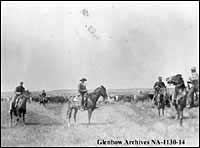The Cattle Drive

Because cattle were often purchased from the sprawling ranches in Montana or even further
away, huge herds would need to be driven
across miles of mountains and prairie before reaching southern Alberta. Generally, the train would follow the same route as had the early
traders and explorers. Eventually called the Macleod Trail, the lower part of the
Great North Trail went from Ft. Benton in Montana north and west, crossing the border near Coutts, past Lethbridge and on to
Ft.
Macleod.
 Ideally, the process of driving cattle was an essentially ordered one: the trail boss would ride ahead and watch for
any hazards and watering holes, occasionally circling the herd to make sure everything was all right. He controlled his men through hand signals and by moving his hat. On either side of the lead were the pointers, who directed the cattle along the route. Two more pairs of riders – the
swing and the flank – kept the cattle moving in a narrow column, while
drag men, in the least popular position, pushed the slower animals ahead amid the dust raised behind the herd. During spring drives, a wagon would follow the animals, picking up calves born along the
way. The wrangler was in charge of the remuda, a string of spare horses driven along with the herd. Trailing cattle,
it seems, was as hard on its equine participants as it was on the men. Ideally, the process of driving cattle was an essentially ordered one: the trail boss would ride ahead and watch for
any hazards and watering holes, occasionally circling the herd to make sure everything was all right. He controlled his men through hand signals and by moving his hat. On either side of the lead were the pointers, who directed the cattle along the route. Two more pairs of riders – the
swing and the flank – kept the cattle moving in a narrow column, while
drag men, in the least popular position, pushed the slower animals ahead amid the dust raised behind the herd. During spring drives, a wagon would follow the animals, picking up calves born along the
way. The wrangler was in charge of the remuda, a string of spare horses driven along with the herd. Trailing cattle,
it seems, was as hard on its equine participants as it was on the men.
At first the herd would need to be driven hard, so they would get used to life on the trail and tire out quickly at night. After a few days, the pace was slowed. By this time the herd had usually arranged itself – sometimes with a particularly intrepid steer or bull in the lead – into the order it would maintain throughout the trip,
averaging twelve or thirteen miles each day.
 The routine of these drives were steady: first an early breakfast for the cowboys and a few hours of grazing for the cattle. Driving until about noon, and then a few more hours of grazing before the final push until nightfall. Before sunset, the boss would signal for the cattle to be put on to bed ground, and then the night herders would take up their watch. The routine of these drives were steady: first an early breakfast for the cowboys and a few hours of grazing for the cattle. Driving until about noon, and then a few more hours of grazing before the final push until nightfall. Before sunset, the boss would signal for the cattle to be put on to bed ground, and then the night herders would take up their watch.
Nightfall was a particularly dangerous time as it was difficult to see the
herd in the dark. If the herd stampeded, spooked by thunder or any other unusual occurrence, the cowboys would have to circle the running multitude in the hope of running back its leaders. If this did not work, one might fire his pistol near the head of the lead animals to make them turn. It would be a long process to gather cattle that had spread
out all over the range.
|

|



